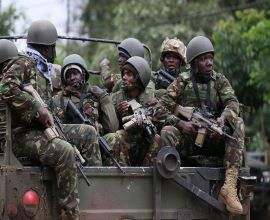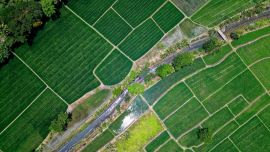Haiti. The source of millions of tons of sugar, indigo and cotton, the richest colony in the 18th-century French empire, the Pearl of the Antilles. Haiti’s riches built the grand townhouses that are still standing today in the exclusive sections of Bordeaux, La Rochelle or Nantes in France.
During European plunder of the so-called New World three centuries ago, the island of Hispaniola was ultimately divided between France and Spain. Haiti is three-eighths of the island; the Dominican Republic makes up the larger part. African slaves provided the blood, sweat and tears to build the economies of both parts. But the contrast between the two parts of the island could not be starker.
Haiti has the distinction of being the first African slave revolt that led to the creation of a nation which exists to-day. It emerged as a nation in 1804 after African slaves drove out the French.
To ensure that slaves elsewhere did not follow the Haitian example and overwhelm their masters, a cultural, economic, and social invisible wall was built around Haiti. Many countries did not acknowledge Haiti. For example, slave-holding US did not recognize Haiti until 1862. The impact of this isolation of Haiti is still felt more than two hundred years later.
In addition, Haiti was forced to pay an indemnity, a payment to France as one condition of peace. In effect, rather than being paid reparations for enslavement, the ex-slaves were forced to compensate France not just for the cost of the war, but also for the loss of property, the slaves.
This payment, initially 150 million francs and later reduced to 90 million francs is the equivalent of $32,535,940,803 in 2022. Haiti struggled to pay the debt for the rest of the nineteenth century.
In 1911, the United States acquired Haiti’s treasury including the debt to France. Thereafter, the US received the payments. In a second sale, in 1922 the National City Bank of New York bought the debt. Haiti continued to make payments, but this time to American investors. The US occupied Haiti from 1915 to 1934 to, among other things, enforce the payments. In 1947, or after a staggering 122 years of paying, Haiti finally made the last payment. An entry in Wikipedia states:
Over the 122 years between 1825 and 1947, the debt severely hampered Haitian economic development as payments of interest and downpayments totaled a significant share of Haitian GDP, constraining the use of domestic financial funds for infrastructure and public services.
In other words, the debt prevented the development of Haiti for 122 years ending in 1947. If the UK had imposed a similar debt on Kenya in 1963, Kenya would probably not afford to build a single highway, a referral hospital, or a university until after 2085! Haiti was choked at birth through a concert orchestrated by France and the United States.
The other part of the island, present day Dominican Republic, copied Haiti and declared independence from Spain in 1821. This was followed by two decades of occupation (by Haiti), attempted return of Spain, and, finally, independence in 1844.
The new country established economic and other ties with other countries. When it defaulted on foreign debts, it too was occupied by the United States (1916-1924). Despite occasional unrest early in the twentieth century, the Dominican Republic is a success. According to the World Bank, it is the seventh largest economy, the fastest growing economy in the western hemisphere averaging a GDP of 5.5% driven by construction, manufacturing, tourism, and mining.
A punitive debt and economic isolation for more than a century has sent Haiti down a very different path from the Dominican Republic.
As a result of the debt for 122 years, and even after 1947, a long line of leaders has tried to ignite the sustained, generations-long push needed to bring progress to the Haitian side of the island. But grinding poverty nurtures instability, sometimes just below the surface. Once in a while, it boils over and others have either been requested or have taken it upon themselves to intervene with force to restore order. Hence, the proposed Kenya-led security force would be the seventh US-sponsored intervention in Haiti, including the 19-year long US Occupation which ended in 1934.
The unrest today is manifested by gangs, extortion rackets, which have effectively replaced civil government in neighborhoods and cities starting with the capital, Port-au-Prince.
The trigger for the current surge in unrest was the assassination of Haiti’s President Jovenel Moïse in July 2021 and his replacement with the current President, Ariel Henry.
Although a handful of people have been arrested for the assassination, there have been persistent allegations that the current President was linked to the broad coalition which organized the murder of President Moise. This has cast a pall of illegitimacy. It also taints the request by the current President for help in battling the gangs.
The catastrophic earthquake of 2021 which left 2,100 dead and more than 12,200 injured only deepened the suffering, stoked instability and strengthened the gangs.
According to UN Secretary General, by September 2023, the gangs controlled over 80% of the capital. The gangs are the de-facto authorities in many neighborhoods and increasingly they share a common objective: the removal of the current President and those around him. For all practical purposes, Haiti has the signs of a civil war.
Against this background, the question as to whether Kenya should lead a multinational force to Haiti must clear many hurdles.
Sending Kenyan police to secure vital installations in Haiti has the appearance of sanitizing and legitimizing past painful interventions, supporting the current leadership which has, at best, a limited mandate from the wananchi of Haiti, and repeating what has failed in the past, but this time, with an African face. It is this discomfort with the mission that bothers many who have nothing but goodwill towards Haiti.
This apprehension was evident right from the start: the undertaking is UN-authorized but is not designated as an official UN peacekeeping mission. There is something which is fundamentally different about this mission compared to others in which Kenya has taken part.
Kenyans speak neither French nor Haitian Creole. Neither do the other members of the would-be mission – Antigua, the Bahamas, Barbuda, and Jamaica. Of the other countries which might send security personnel, Chile, Guyana, Senegal, and Spain, only the Senegalese would be able to communicate in French to a Haitian in the Street. Kenya is eminently unqualified to lead this effort. This is a mission which is destined to fail.
This is quite apart from whether, under Kenyan laws, it is legal or constitutional to send Kenyans to police Haitians.
There is no reason to believe that offering a few thousand police for one year will succeed where larger, sustained occupations have failed. Only Haitians can harness Haitian social compact and direct it towards uplifting the country.
In the end, past peace-keeping missions involving Kenya have been in situations where the morality of the interventions was clear. In this case, it is not clear Kenya would be on the side of what is good for Haiti.



